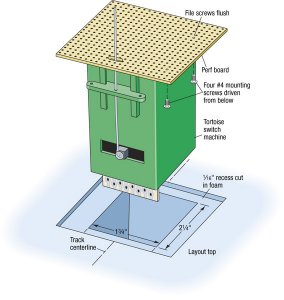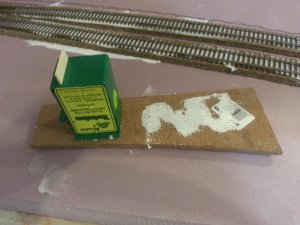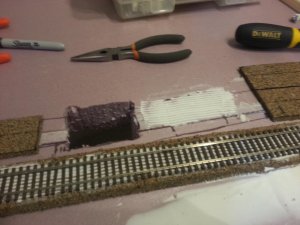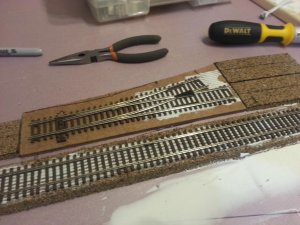kjchronister
Member
A few years ago, I went to 2" foam top for my layouts, with no plywood underlayment. This gave me 2 tortoise issues: 1) even with heavier wire, that long of a throw was always tricky (for me at least) to configure and make strong enough. 2) with no plywood, nothing to screw into...
So I moved to the 'recessed board' method like the one shown here...
BUT, this was a theory vs. practice concern. Great as the picture looks, I found it darned-near impossible to dado out a nice, even, flat recess in my foam. No matter how sharp/new a blade I used it always ended up "chunky" and uneven - rather like you see with this guy doing this same in this video: https://www.youtube.com/watch?v=d87H-zF7wXg Tried using a mini-router attachment on my dremel, which was better, but still 'grabbed' and left chunks and uneven edges. I normally ended up having to make the recess too deep, fill it with caulk, and painstakingly tease the thing up/down/left/right until I got it as flat and even as possible - And not matter how careful, too often I ended up with something uneven: a bit too high, a bit too low, tipped left or right, a bump on one end, etc...
I found (for me at least) a better way. To heck with all this recessing...
I now create entire 'turnout sandwich' pieces on 15/32" hardboard, which exactly matches the height of my cork roadbed. I cut the board to fit, drill a hole in the right place, mount the turnout, flip it over and mount the tortoise, wire it up and bingo. Entire turnout sandwich ready to just drop in. I still have to carve out a hole for the tortoise itself, but this can be uneven without harm - it's non-operational and hidden by the "plate".
Also nice that you can do the entire thing at the workbench including full-on testing of the turnout operation. No more fiddling about on the layout itself...
Yes the plate is on the surface, not recessed, but after ballasting it's unnoticeable... I originally would cut a slope into the edges of the board to match the cork roadbed. But I've found that it works better to leave the edges straight, especially with the "ballast lightly!" directive for turnouts. The ballast on top sits more nicely, and then you just mound it up against the sides to form a slope. (Normally I trim the board a little more carefully to match the roadbed edges - but this one happens to be in a staging area, so I was more quick-n-dirty about it).
I use a bit of caulk which keeps it nice and stable. But should I ever have a problem, it takes almost no effort to pop that loose, remove the whole thing, and correct the issue.
Just what works for me, sharing if anyone else might benefit...



So I moved to the 'recessed board' method like the one shown here...

BUT, this was a theory vs. practice concern. Great as the picture looks, I found it darned-near impossible to dado out a nice, even, flat recess in my foam. No matter how sharp/new a blade I used it always ended up "chunky" and uneven - rather like you see with this guy doing this same in this video: https://www.youtube.com/watch?v=d87H-zF7wXg Tried using a mini-router attachment on my dremel, which was better, but still 'grabbed' and left chunks and uneven edges. I normally ended up having to make the recess too deep, fill it with caulk, and painstakingly tease the thing up/down/left/right until I got it as flat and even as possible - And not matter how careful, too often I ended up with something uneven: a bit too high, a bit too low, tipped left or right, a bump on one end, etc...
I found (for me at least) a better way. To heck with all this recessing...
I now create entire 'turnout sandwich' pieces on 15/32" hardboard, which exactly matches the height of my cork roadbed. I cut the board to fit, drill a hole in the right place, mount the turnout, flip it over and mount the tortoise, wire it up and bingo. Entire turnout sandwich ready to just drop in. I still have to carve out a hole for the tortoise itself, but this can be uneven without harm - it's non-operational and hidden by the "plate".
Also nice that you can do the entire thing at the workbench including full-on testing of the turnout operation. No more fiddling about on the layout itself...
Yes the plate is on the surface, not recessed, but after ballasting it's unnoticeable... I originally would cut a slope into the edges of the board to match the cork roadbed. But I've found that it works better to leave the edges straight, especially with the "ballast lightly!" directive for turnouts. The ballast on top sits more nicely, and then you just mound it up against the sides to form a slope. (Normally I trim the board a little more carefully to match the roadbed edges - but this one happens to be in a staging area, so I was more quick-n-dirty about it).
I use a bit of caulk which keeps it nice and stable. But should I ever have a problem, it takes almost no effort to pop that loose, remove the whole thing, and correct the issue.
Just what works for me, sharing if anyone else might benefit...



Last edited by a moderator:

